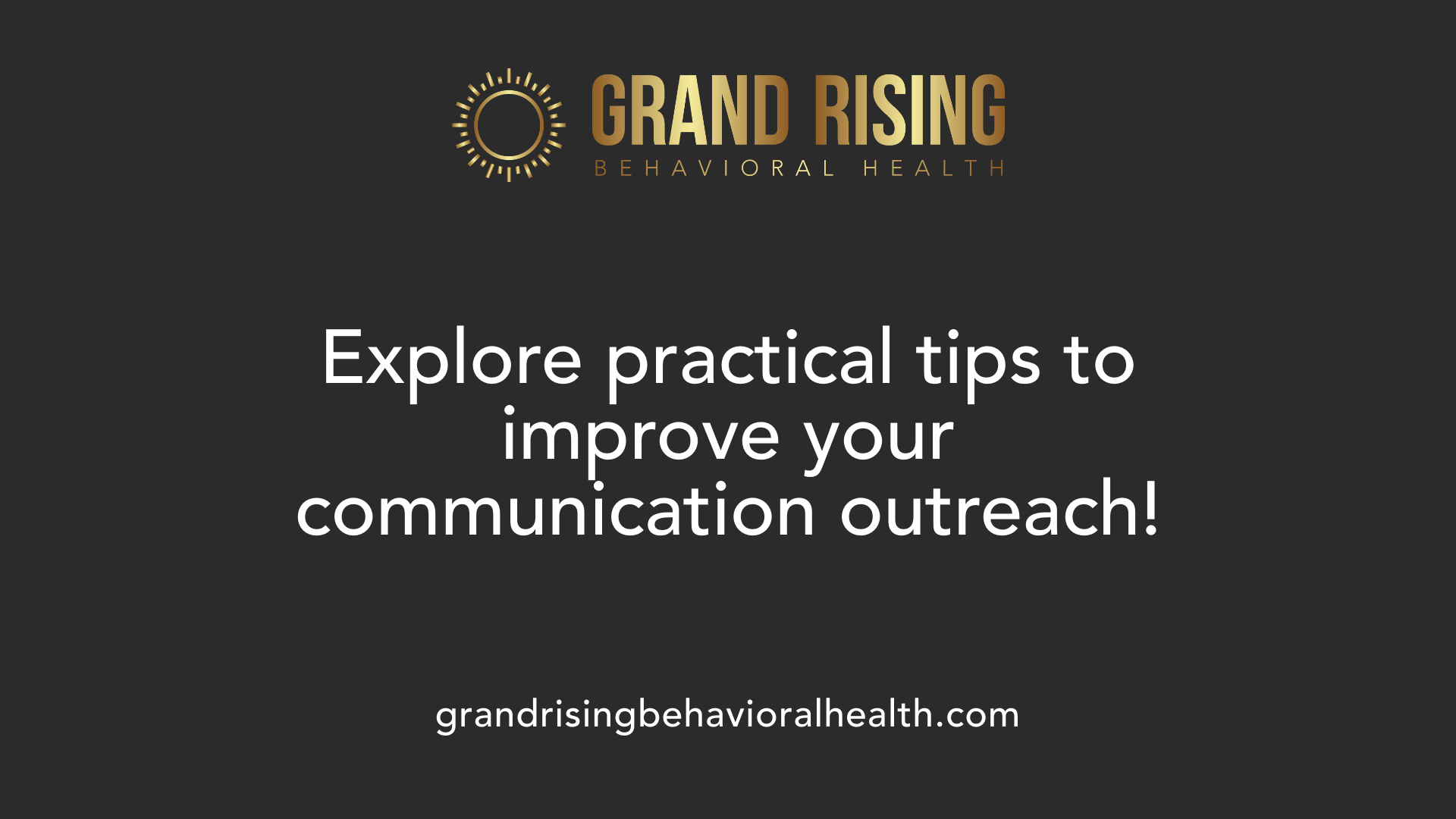How to Practice Mindful Communication
Unlocking the Secret to Meaningful Conversations

Understanding Mindful Communication
Mindful communication is more than just talking or listening; it's about engaging with others with a heightened sense of awareness and intention. By incorporating elements like empathy and active listening, this approach can significantly enhance communication, foster stronger relationships, and create a positive impact, whether in personal interactions or workplace settings. This article explores how to effectively practice mindful communication and the profound benefits it offers.
The Essence of Mindful Communication

What is mindful communication?
Mindful communication is the practice of engaging in conversations with full awareness and intention, incorporating active listening, empathy, and compassion. It involves recognizing defensive reactions and managing emotional safety during interactions, allowing individuals to navigate communication barriers effectively. By observing one’s communication patterns, individuals can enhance their emotional regulation and interpersonal relationships. Mindful communication also encourages openness and vulnerability, fostering deeper connections and self-discovery through interactions.
Elements of mindful communication
To achieve mindful communication, several elements play a critical role:
- Attention: Being present and engaging fully in the conversation, especially by minimizing distractions.
- Intention: Setting clear purposes for conversations, such as fostering understanding or building connection.
- Empathy: Maintaining compassion and consideration for the emotions and perspectives of others.
- Active Listening: Putting aside personal biases to fully attend to the speaker's message.
- Non-judgment: Recognizing and acknowledging one’s judgments without allowing them to influence the conversation negatively.
- Generous Interpretation: Viewing the discussion from a positive perspective to facilitate constructive dialogue.
By integrating these elements into daily interactions, individuals can transform their communication style, leading to enrichened relational dynamics. This approach is particularly beneficial in high-stress environments like healthcare, where mindful communication can enhance overall well-being and patient-centered care.
Why Mindful Communication Matters

What are the benefits of practicing mindful communication?
Practicing mindful communication offers numerous benefits that positively influence interactions in both personal and professional spheres.
Enhanced Relationships: Mindful communication fosters stronger connections through improved empathy and emotional regulation. By understanding others’ perspectives, individuals can respond more compassionately, reducing conflicts and enhancing relational bonds.
Reduction of Misunderstandings: Clear and precise communication diminishes the likelihood of misinterpretations. By being present and attentive, both parties are more aligned, leading to fewer assumptions and clearer dialogues.
Increased Empathy: Engaging mindfully encourages individuals to understand emotional cues, promoting a culture of respect. This understanding is especially valuable in team settings, improving collaboration and morale.
Resilience and Decreased Stress: Mindful communication equips individuals with the tools to manage stress and conflicts calmly. By maintaining focus and a steady demeanor, they can navigate challenging conversations without becoming defensive.
Enhanced Self-Awareness: The practice cultivates self-awareness regarding one’s own communication style and the impact of one’s words, leading to emotional intelligence and personal growth.
In summary, these benefits collectively contribute to a more positive atmosphere, enhancing overall engagement and satisfaction in various aspects of life.
Steps to Practicing Mindful Communication

What are the 5 mindful steps in communication?
The five mindful steps in communication, derived from the Five Facet Mindfulness Questionnaire, are essential for enhancing awareness and presence in conversations:
- Observing: Remain alert to both your own thoughts and the external environment, noticing feelings, emotions, and bodily sensations.
- Describing: Articulate observations without interpretation or judgment. Focus on what you sense rather than jumping to conclusions about it.
- Acting with Awareness: Engage fully in your current communication instead of going on autopilot. This means being conscious of your words and their impact.
- Nonjudging of Inner Experience: Approach your thoughts and emotions without labeling them as good or bad. Recognizing this helps in maintaining openness during interactions.
- Nonreactivity to Inner Experience: Acknowledge distressing thoughts without impulsively responding to them. This is vital for fostering calm and thoughtful exchanges.
Adopting mindful practices
To adopt mindful communication practices effectively, consider the following techniques:
- Set Clear Intentions: Prior to discussions, clarify your goals, whether it’s to listen, understand, or share.
- Stay Present and Engaged: Minimize distractions and fully immerse yourself in conversations to enrich interactions.
- Practice Compassion: Approach conversations with empathy, recognizing and valuing the emotions of others.
These steps enhance clarity and reduce conflicts. Over time, consistent application of these techniques can lead to more rewarding and constructive dialogues.
Engaging Mindfully in Conversations
How can I practice mindfulness in conversation?
To practice mindfulness in conversation, start with mindful listening, which means giving your full attention to the speaker. This involves minimizing distractions and fully engaging in the dialogue. One effective technique is looping, where you summarize what the speaker has said to confirm your understanding. This not only shows that you are listening but also ensures effective communication.
Enhancing empathy in dialogues
Another approach is the practice of dipping, where you periodically check in with your own feelings and emotions during the conversation. This self-awareness can help in identifying any internal distractions that might interfere with your ability to be present.
Engaging in exercises that involve taking turns in speaking and listening while acknowledging feelings can deepen understanding and empathy in interactions. Utilizing these techniques nurtures kindness and helps you navigate life's challenges collaboratively, leading to more connected and meaningful conversations.
By integrating mindfulness into conversations, you not only improve your communicative effectiveness but also cultivate stronger relationships with those around you.
Practical Tips for Mindful Communication

What are some practical tips for practicing mindful communication?
To enhance your mindful communication skills, start with the 3 P’s: Precision, Pace, and Pause.
- Precision: Speak clearly and deliberately to convey your message without confusion. Simplicity is essential; choose words carefully to enhance clarity.
- Pace: Speak slowly, maintaining an appropriate emotional tone. This helps facilitate a calm atmosphere in conversations.
- Pause: Take a moment to reflect before responding. This prevents impulsive reactions and allows for thoughtful engagement.
Techniques for improving communication
Practicing active listening is key to mindful communication. This means giving your full attention to the speaker without preparing a response while they speak. Here are some techniques:
- Paraphrase what you hear: Confirm your understanding to ensure clarity.
- Ask clarifying questions: This encourages a deeper dialogue, enhancing mutual understanding.
- Nonverbal cues: Pay attention to your body language and eye contact. These can significantly influence how your message is received.
Creating open environments
To foster a supportive environment for conversation, ensure that everyone feels comfortable sharing their thoughts. Here’s how:
- Encourage openness: Create a judgment-free zone where feelings can be expressed without fear.
- Acknowledge emotions: Recognize and validate others' feelings to create a sense of safety.
- Practice generosity in interpretation: Approach conversations with an understanding mindset to keep discussions constructive.
These practical strategies can significantly improve your engagement in conversations, deepen relationships, and enhance clarity, leading to more fulfilling interactions.
Bringing Mindful Communication to the Workplace

How can mindful communication be applied in the workplace?
Mindful communication in the workplace can significantly enhance team dynamics by fostering collaboration and minimizing conflicts. Two core components are active listening and emotional intelligence.
Active Listening: This involves fully engaging with a speaker without distractions. By maintaining eye contact and focusing on their words, employees can promote clearer understanding and deeper connections. This practice encourages patience and respect during discussions, leading to an environment where everyone feels valued.
Emotional Intelligence: Recognizing and managing one's emotions while empathizing with colleagues helps improve relational dynamics. By being aware of emotional states, employees can respond appropriately, paving the way for effective collaboration. Moreover, mindful speaking incorporates clarity and intentionality, ensuring messages are effectively delivered while being aware of nonverbal cues.
Creating a Culture of Openness: By promoting a culture of transparency and trust, organizations can nurture open dialogue. This approach ultimately improves employee engagement and productivity, making it essential in today’s fast-paced work settings.
What are some exercises to improve mindful communication skills?
To enhance mindful communication skills, several pragmatic exercises can be practiced:
- Focused Breathing: Practicing focused breathing before conversations can calm the mind and foster intentional presence.
- Active Listening Techniques: Try paraphrasing the speaker's words or allowing silent pauses to ensure clarity and understanding.
- Traffic Light Model: Utilize the traffic light analogy to recognize your communication states: red for defensiveness, yellow for hesitation, and green for openness.
- Setting Intentions: Before any important conversation, establish clear intentions to guide your interactions towards empathy.
- Fostering Resilience: Building emotional resilience through mindfulness practices can significantly enhance your ability to navigate conflicts and maintain positive relationships within the workplace.
Incorporating these strategies can create a more supportive atmosphere where teamwork thrives, and communication becomes a catalyst for success.
Transforming Interactions through Mindfulness
By embracing mindful communication, you open the door to more meaningful interactions, whether in personal relationships or professional environments. These practices not only improve emotional intelligence and empathy but also lead to healthier conversations and stronger connections. Remember, the journey to becoming a skilled mindful communicator is ongoing and can significantly transform how you engage with those around you, making each exchange intentional, compassionate, and enriching.
References
- How Mindful Communication Makes Us More Compassionate
- Mindful Communication - SIGMA Assessment Systems
- Four Mindful Communication Skills for Difficult Conversations
- 4 Ways to Practice Mindful Communication at Work - HSI
- Practicing 6 Points of Mindful Speech - Journey
- How To Become More Mindful Of Your Communication - Forbes
- 1.5: Understanding Mindful Communication - Social Sci LibreTexts
- Five Simple Ways to Start Communicating More Mindfully
- 3 important lessons on mindful conversation
More Resources
A team ready to start your journey.
Get in touch — today.
We are a safe space – a haven for exceptional individuals to receive discreet, personalized, in-person treatment and care.
.png)









